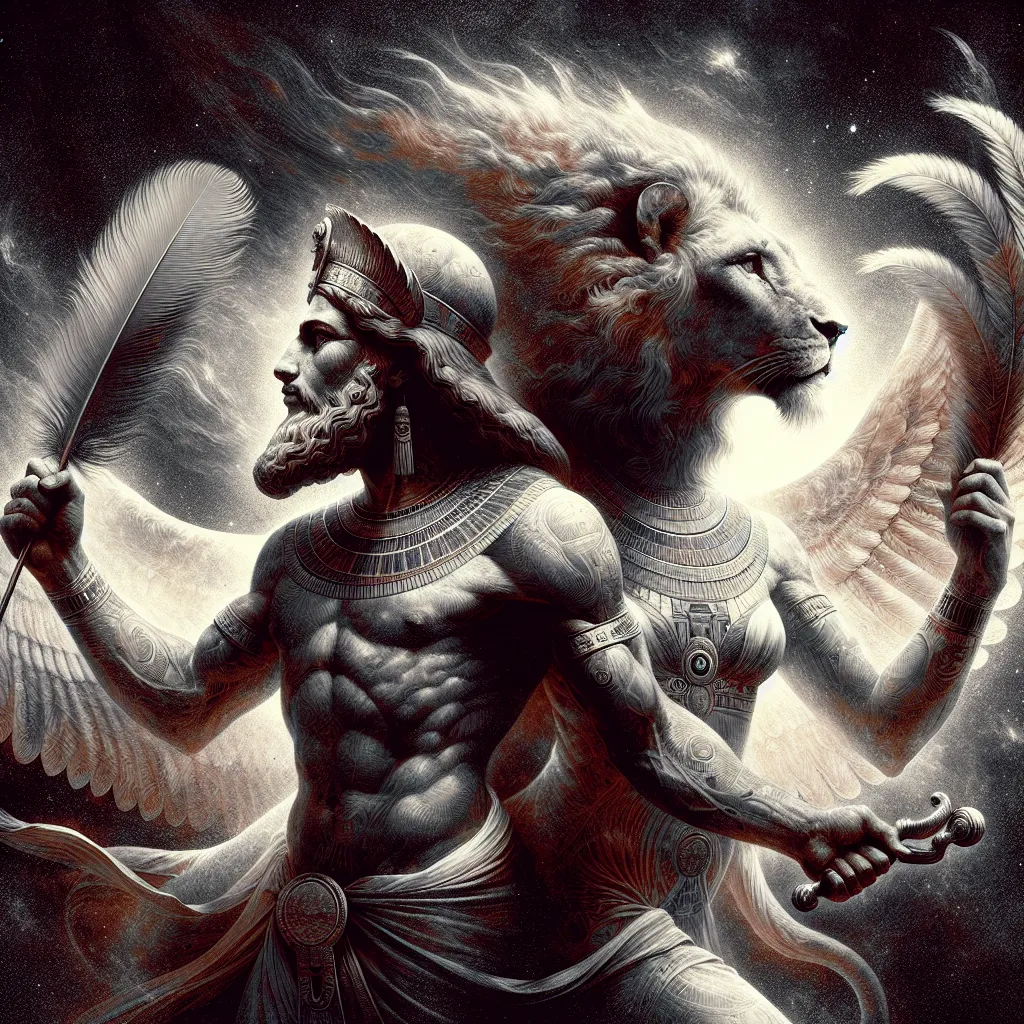
- Published on
- Authors

- Name
- You
The Gods of Breath: Tefnut and Shu in Egyptian Mythology
The intricate web of Egyptian mythology introduces us to a plethora of deities, each symbolizing different elements of the cosmos. Among these divine beings, Tefnut and Shu hold a significant place as the deities of moisture and air, respectively. Their roles are not only cosmically essential but also philosophically profound, blending advanced science and mystical wisdom.
Who are Tefnut and Shu?
In the primordial times of Egyptian mythology, Tefnut and Shu emerge as the offspring of the sun god Ra (sometimes Atum-Ra). Shu represents air, the breath of life, while Tefnut embodies moisture, an essential element for life.
Tefnut: The Goddess of Moisture
Tefnut is often depicted as a lion-headed goddess, representing the vital essence of moisture that nourishes all living beings. She is closely associated with the concept of Maat, which embodies cosmic order and balance. Ancient Egyptians believed that without Tefnut’s presence, the balance of life-giving elements would be disrupted.
Shu: The God of Air
Shu, on the other hand, is depicted as a man wearing a feathered headdress or sometimes just a feather to symbolize the invisibility and omnipresence of air. Shu's domain is the atmosphere, and he is often seen separating Nut (the sky) and Geb (the earth), representing his role in maintaining the structure of the cosmos.
The Mythological Significance
The Separation of Nut and Geb
Shu and Tefnut, along with their children—Nut and Geb—form the essential components of the visible universe. As the myth goes, Nut and Geb were fervently in love and were inseparable. However, Ra, worried about their union, commanded Shu to intervene. Using his strength, Shu lifted Nut away from Geb, forming the sky and maintaining the separation needed for the earthly and celestial realms to function.
The Balance of Elements: Air and Moisture
Shu and Tefnut’s roles are integral to the concept of life itself. In an advanced scientific perspective, one might compare them to the balance of oxygen and water in the air. Without moisture (Tefnut), air (Shu) would be inhospitable, dry, and unable to sustain life. Similarly, without air, moisture would stagnate and fail to facilitate various biogeochemical cycles crucial for life.
Harmonizing Science and Mysticism
While the mythological narrative provides rich allegories for the intrinsic balance of elements, modern science echoes these principles. The hydrological cycle involves the constant movement of water between the earth and the atmosphere, showcasing a dynamic equilibrium that ancient Egyptians personified through Tefnut and Shu.
Mystical Practices and Rituals
Invocation of Tefnut and Shu
Priests and practitioners in ancient Egypt would perform rituals to honor Tefnut and Shu, invoking their divine presence to ensure harmony and balance in nature.
Ritual Components:
- Offerings: Incense, water, and specially prepared foods.
- Chants and Hymns: Recitations to Tefnut and Shu, often focusing on their roles in maintaining cosmic equilibrium.
- Sacred Feathers: Used to symbolize Shu’s breath and the essential air.
Ritual Example
| Element | Ritual Action | Purpose |
|---|---|---|
| Incense | Burning frankincense and myrrh | To purify the air and invoke Shu |
| Water Libations | Pouring water on sacred ground | To honor Tefnut and ensure the flow of moisture |
| Chants | Reciting hymns to Shu and Tefnut | To call upon balance and harmony |
By understanding and honoring these deities, one can appreciate the intricate balance of the natural world, echoing the ancient wisdom that remains relevant in our scientifically advanced age.
Conclusion
Tefnut and Shu, as deities of moisture and air, are profound symbols of life and balance in Egyptian mythology. Their stories encapsulate the unity of natural forces essential for sustaining life. They remind us that, be it through mythology or science, the harmony of elements is fundamental to our existence. Their mythos, blending mystical and empirical insights, continues to inspire and educate generations on the delicate equilibrium that governs our world.
